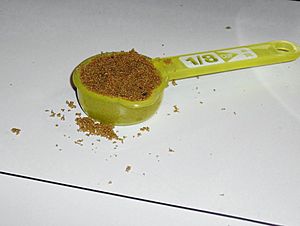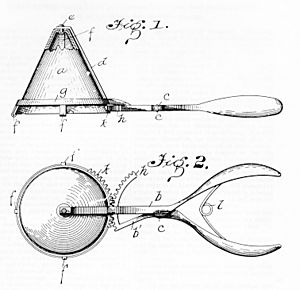Scoop (utensil) facts for kids
A scoop is a special kind of spoon used to serve food. You might use one to dish out ice cream or to measure flour for baking.
In the food world, there are three main types of scoops:
- A disher is used to measure out exact portions, like for cookie dough or melon balls. They are also often used for ice cream, even though some makers suggest not using them for very frozen foods.
- An ice cream scoop is made specifically for serving ice cream.
- A general scoop is used to measure or move large amounts of dry foods, like rice, flour, or sugar.
Contents
Dishers: Perfect Portions
Dishers usually look like half a ball, similar to an ice cream scoop. Measuring scoops, however, are often shaped like a tube. Scoops used for moving large amounts of food are usually shaped like a small shovel.
Some dishers have a special lever. This lever helps push the food out easily, so it doesn't stick inside the scoop. Dishers are often sized by how many scoops fit into a quart (a unit of liquid measure). They can also be sized by how many ounces or tablespoons they hold, or by the size of their bowl.
Ice Cream Scoops: A Cool Tool
Some fancy ice cream scoops have a special liquid inside their handle. This liquid helps to keep the metal scoop from getting too cold and sticking to the ice cream. This makes serving much easier!
The History of the Ice Cream Scoop
Did you know the ice cream scoop was invented because ice cream kept sticking to spoons? Alfred L. Cralle worked in a drug store and a hotel in Pittsburgh, Pennsylvania. He saw how hard it was for servers to scoop ice cream. So, he decided to create a better tool.
On June 10, 1896, Cralle applied for a patent for his new invention. A patent is like an official document that says you invented something. He received his patent on February 2, 1897. His invention, called the "Ice Cream Mold and Disher," had a built-in scraper. This scraper allowed people to scoop ice cream with just one hand! Many modern ice cream scoops still use Cralle's clever design.
Transfer Scoops: Moving Bulk Foods
Transfer scoops are also known as utility scoops. They are used to move large amounts of food from big storage containers into smaller ones. For example, you might use one to scoop flour from a huge bag into a smaller jar. These scoops usually don't have any measurement lines. Their main job is to move food quickly, so stopping to measure would slow things down.
Other Types of Scoops

There are many other kinds of scoops designed for specific uses:
- Ice scoop
- Coffee scoop
- Spooner
- Dipper
- French fry scoop
Images for kids
See also
 In Spanish: Sacabolas de helado para niños
In Spanish: Sacabolas de helado para niños







